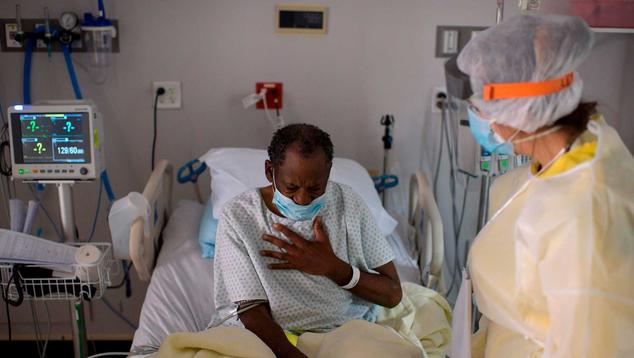Story Highlights
- Half in U.S. now, vs. 45% in 2019, concerned about health-related bankruptcy
- 15%, including 20% of non-White adults, carry long-term medical debt
- Lowering drug prices a key voting issue for 35% of adults
WASHINGTON, D.C. -- Half of all U.S. adults are concerned that a major health event in their household could lead to bankruptcy, an increase from 45% measured in early 2019 (PDF download). These results, based on a new study by West Health and Gallup, also show that the percentage of non-White adults who harbor this concern has risen from 52% to 64%.
| January-February 2019 | July 2020 | Change | ||||||||||||||||||||||||||||||||||||||||||||||||||||||||||||||||||||||||||||||||||||||||||||||||||
|---|---|---|---|---|---|---|---|---|---|---|---|---|---|---|---|---|---|---|---|---|---|---|---|---|---|---|---|---|---|---|---|---|---|---|---|---|---|---|---|---|---|---|---|---|---|---|---|---|---|---|---|---|---|---|---|---|---|---|---|---|---|---|---|---|---|---|---|---|---|---|---|---|---|---|---|---|---|---|---|---|---|---|---|---|---|---|---|---|---|---|---|---|---|---|---|---|---|---|---|---|
| % Extremely concerned/ Concerned |
% Extremely concerned/ Concerned |
pct. pts. | ||||||||||||||||||||||||||||||||||||||||||||||||||||||||||||||||||||||||||||||||||||||||||||||||||
| U.S. total | 45 | 50 | +5* | |||||||||||||||||||||||||||||||||||||||||||||||||||||||||||||||||||||||||||||||||||||||||||||||||
| Gender | ||||||||||||||||||||||||||||||||||||||||||||||||||||||||||||||||||||||||||||||||||||||||||||||||||||
| Women | 47 | 51 | +4 | |||||||||||||||||||||||||||||||||||||||||||||||||||||||||||||||||||||||||||||||||||||||||||||||||
| Men | 42 | 49 | +7* | |||||||||||||||||||||||||||||||||||||||||||||||||||||||||||||||||||||||||||||||||||||||||||||||||
| Race | ||||||||||||||||||||||||||||||||||||||||||||||||||||||||||||||||||||||||||||||||||||||||||||||||||||
| White adults | 41 | 43 | +2 | |||||||||||||||||||||||||||||||||||||||||||||||||||||||||||||||||||||||||||||||||||||||||||||||||
| Non-White adults | 52 | 64 | +12* | |||||||||||||||||||||||||||||||||||||||||||||||||||||||||||||||||||||||||||||||||||||||||||||||||
| Age | ||||||||||||||||||||||||||||||||||||||||||||||||||||||||||||||||||||||||||||||||||||||||||||||||||||
| 18-29 | 43 | 55 | +12* | |||||||||||||||||||||||||||||||||||||||||||||||||||||||||||||||||||||||||||||||||||||||||||||||||
| 30-49 | 46 | 55 | +9* | |||||||||||||||||||||||||||||||||||||||||||||||||||||||||||||||||||||||||||||||||||||||||||||||||
| 50-64 | 52 | 48 | -4 | |||||||||||||||||||||||||||||||||||||||||||||||||||||||||||||||||||||||||||||||||||||||||||||||||
| 65+ | 38 | 40 | +2 | |||||||||||||||||||||||||||||||||||||||||||||||||||||||||||||||||||||||||||||||||||||||||||||||||
| * Statistically significant change (p<.05), design effect included | ||||||||||||||||||||||||||||||||||||||||||||||||||||||||||||||||||||||||||||||||||||||||||||||||||||
| Gallup-West Health U.S. Healthcare Study, July 2020 | ||||||||||||||||||||||||||||||||||||||||||||||||||||||||||||||||||||||||||||||||||||||||||||||||||||
This study is based on 1,007 interviews with U.S. adults conducted from July 1-24, 2020. Over the past year, concerns about medical bankruptcy have increased 12 and nine percentage points, respectively, among adults aged 18-29 and 30-49. Fifty-five percent of both groups now report being extremely concerned or concerned that a major health event could bankrupt them. Men's concern is up seven points to 49% and is now statistically tied with concern among women (51%).
One-Fifth of Non-White Adults Carry Long-Term Medical Debt
Amid rising concerns nationally about bankruptcy arising from a significant health event, 15% of adults report that at least one person in their household currently has medical debt that will not be repaid -- either in full or in part -- within the next 12 months. This includes 12% of White adults and 20% of non-White adults.
Those in households earning less than $40,000 per year are more than four times as likely as those in households earning $100,000 or more to be carrying long-term medical debt (28% vs. 6%, respectively). The rate is also about twice as high among self-identified political independents (18%) and Democrats (16%) as among Republicans (8%).
| Yes, have medical debt | ||||||||||||||||||||||||||||||||||||||||||||||||||||||||||||||||||||||||||||||||||||||||||||||||||||
|---|---|---|---|---|---|---|---|---|---|---|---|---|---|---|---|---|---|---|---|---|---|---|---|---|---|---|---|---|---|---|---|---|---|---|---|---|---|---|---|---|---|---|---|---|---|---|---|---|---|---|---|---|---|---|---|---|---|---|---|---|---|---|---|---|---|---|---|---|---|---|---|---|---|---|---|---|---|---|---|---|---|---|---|---|---|---|---|---|---|---|---|---|---|---|---|---|---|---|---|---|
| % | ||||||||||||||||||||||||||||||||||||||||||||||||||||||||||||||||||||||||||||||||||||||||||||||||||||
| U.S. total | 15 | |||||||||||||||||||||||||||||||||||||||||||||||||||||||||||||||||||||||||||||||||||||||||||||||||||
| Race | ||||||||||||||||||||||||||||||||||||||||||||||||||||||||||||||||||||||||||||||||||||||||||||||||||||
| White adults | 12 | |||||||||||||||||||||||||||||||||||||||||||||||||||||||||||||||||||||||||||||||||||||||||||||||||||
| Non-White adults | 20 | |||||||||||||||||||||||||||||||||||||||||||||||||||||||||||||||||||||||||||||||||||||||||||||||||||
| Annual household income | ||||||||||||||||||||||||||||||||||||||||||||||||||||||||||||||||||||||||||||||||||||||||||||||||||||
| Less than $40,000 | 28 | |||||||||||||||||||||||||||||||||||||||||||||||||||||||||||||||||||||||||||||||||||||||||||||||||||
| $40,000-<$100,000 | 12 | |||||||||||||||||||||||||||||||||||||||||||||||||||||||||||||||||||||||||||||||||||||||||||||||||||
| $100,000+ | 6 | |||||||||||||||||||||||||||||||||||||||||||||||||||||||||||||||||||||||||||||||||||||||||||||||||||
| Political identity | ||||||||||||||||||||||||||||||||||||||||||||||||||||||||||||||||||||||||||||||||||||||||||||||||||||
| Independent | 18 | |||||||||||||||||||||||||||||||||||||||||||||||||||||||||||||||||||||||||||||||||||||||||||||||||||
| Democrat | 16 | |||||||||||||||||||||||||||||||||||||||||||||||||||||||||||||||||||||||||||||||||||||||||||||||||||
| Republican | 8 | |||||||||||||||||||||||||||||||||||||||||||||||||||||||||||||||||||||||||||||||||||||||||||||||||||
| Gallup-West Health U.S. Healthcare Study, July 2020 | ||||||||||||||||||||||||||||||||||||||||||||||||||||||||||||||||||||||||||||||||||||||||||||||||||||
One-Quarter of U.S. Adults Must Borrow Money for $500 Medical Bill
With substantial percentages of adults reporting that they currently have medical debt that they cannot pay in a year or less, it is probably unsurprising that 26% report they would need to borrow money to pay a $500 medical bill. To do this, 12% say they would use a credit card or get a loan from a financial institution, while another 14% would borrow from a family member or friend. For some persons, these forms of borrowing could ordinarily be characterized by prompt repayment (such as simply paying off the credit card at the end of the month), but for many others, it is likely to feed into a cycle of accumulating medical debt that cannot be readily repaid.
The need to borrow money to pay a $500 medical bill is particularly common among non-White adults (43%) and those living in households earning less than $40,000 per year (46%).
| U.S. Total | White adults | Non-White adults | $100,000+ | $40,000- <$100,000 |
Less than $40,000 |
||||||||||||||||||||||||||||||||||||||||||||||||||||||||||||||||||||||||||||||||||||||||||||||
|---|---|---|---|---|---|---|---|---|---|---|---|---|---|---|---|---|---|---|---|---|---|---|---|---|---|---|---|---|---|---|---|---|---|---|---|---|---|---|---|---|---|---|---|---|---|---|---|---|---|---|---|---|---|---|---|---|---|---|---|---|---|---|---|---|---|---|---|---|---|---|---|---|---|---|---|---|---|---|---|---|---|---|---|---|---|---|---|---|---|---|---|---|---|---|---|---|---|---|---|
| % | % | % | % | % | % | ||||||||||||||||||||||||||||||||||||||||||||||||||||||||||||||||||||||||||||||||||||||||||||||
| Funds from a checking or savings account that were not dedicated to healthcare-related expenses | 54 | 62 | 40 | 61 | 63 | 39 | |||||||||||||||||||||||||||||||||||||||||||||||||||||||||||||||||||||||||||||||||||||||||||||
| A medical flexible spending account or health savings account | 14 | 17 | 11 | 30 | 11 | 8 | |||||||||||||||||||||||||||||||||||||||||||||||||||||||||||||||||||||||||||||||||||||||||||||
| A credit card or a loan from a financial institution | 12 | 9 | 17 | 7 | 13 | 15 | |||||||||||||||||||||||||||||||||||||||||||||||||||||||||||||||||||||||||||||||||||||||||||||
| A loan from a family member or friend | 14 | 8 | 26 | 1 | 9 | 31 | |||||||||||||||||||||||||||||||||||||||||||||||||||||||||||||||||||||||||||||||||||||||||||||
| Credit card or any loan type | 26 | 17 | 43 | 8 | 22 | 46 | |||||||||||||||||||||||||||||||||||||||||||||||||||||||||||||||||||||||||||||||||||||||||||||
| Gallup-West Health U.S. Healthcare Study, July 2020 | |||||||||||||||||||||||||||||||||||||||||||||||||||||||||||||||||||||||||||||||||||||||||||||||||||
Fourteen percent of U.S. adults report using a medical flexible spending or health savings account to pay medical bills, but use of these tax-benefited financial tools is more than twice as common (30%) among those in households with $100,000 or more in annual income.
Drug Pricing Continues to Influence Candidate Choice for 35% of Adults
About one-third (35%) of Americans say that lowering the cost of prescription drugs is either the single most important issue (5%) or among the most important issues (30%) that will influence their vote in 2020. This is up five percentage points since February, returning to the level measured in September 2019. Another 40% report that the issue is of "mid-range" importance, while 24% report that it is the least or among the least important.
Across key subgroups, little change has been measured since September. Views of women (36%) and men (33%) have converged since last fall, but neither is significantly different from 2019 views. Race and household income, in turn, currently closely match 2019 results. Non-White adults continue to place much higher importance on the issue than their White adult counterparts (48% vs. 29%, respectively), while half (52%) of respondents from households earning under $40,000 per year continue to report that the issue will be highly influential to their vote.
| September 2019 | February 2020 | July 2020 | Change since 2019 | |||||||||||||||||||||||||||||||||||||||||||||||||||||||||||||||||||||||||||||||||||||||||||||||||
|---|---|---|---|---|---|---|---|---|---|---|---|---|---|---|---|---|---|---|---|---|---|---|---|---|---|---|---|---|---|---|---|---|---|---|---|---|---|---|---|---|---|---|---|---|---|---|---|---|---|---|---|---|---|---|---|---|---|---|---|---|---|---|---|---|---|---|---|---|---|---|---|---|---|---|---|---|---|---|---|---|---|---|---|---|---|---|---|---|---|---|---|---|---|---|---|---|---|---|---|---|
| % | % | % | pct. pts. | |||||||||||||||||||||||||||||||||||||||||||||||||||||||||||||||||||||||||||||||||||||||||||||||||
| U.S. total | 35 | 30 | 35 | 0 | ||||||||||||||||||||||||||||||||||||||||||||||||||||||||||||||||||||||||||||||||||||||||||||||||
| Gender | ||||||||||||||||||||||||||||||||||||||||||||||||||||||||||||||||||||||||||||||||||||||||||||||||||||
| Women | 41 | 33 | 36 | -5 | ||||||||||||||||||||||||||||||||||||||||||||||||||||||||||||||||||||||||||||||||||||||||||||||||
| Men | 29 | 28 | 33 | +4 | ||||||||||||||||||||||||||||||||||||||||||||||||||||||||||||||||||||||||||||||||||||||||||||||||
| Race | ||||||||||||||||||||||||||||||||||||||||||||||||||||||||||||||||||||||||||||||||||||||||||||||||||||
| White adults | 29 | 23 | 29 | 0 | ||||||||||||||||||||||||||||||||||||||||||||||||||||||||||||||||||||||||||||||||||||||||||||||||
| Non-White adults | 48 | 45 | 48 | 0 | ||||||||||||||||||||||||||||||||||||||||||||||||||||||||||||||||||||||||||||||||||||||||||||||||
| Annual household income | ||||||||||||||||||||||||||||||||||||||||||||||||||||||||||||||||||||||||||||||||||||||||||||||||||||
| Less than $40,000 | 52 | 45 | 52 | 0 | ||||||||||||||||||||||||||||||||||||||||||||||||||||||||||||||||||||||||||||||||||||||||||||||||
| $40,000-<$100,000 | 31 | 31 | 29 | -2 | ||||||||||||||||||||||||||||||||||||||||||||||||||||||||||||||||||||||||||||||||||||||||||||||||
| $100,000+ | 19 | 14 | 22 | +3 | ||||||||||||||||||||||||||||||||||||||||||||||||||||||||||||||||||||||||||||||||||||||||||||||||
| Gallup-West Health U.S. Healthcare Study, July 2020 | ||||||||||||||||||||||||||||||||||||||||||||||||||||||||||||||||||||||||||||||||||||||||||||||||||||
Implications
The sharp rise in U.S. healthcare costs, which was already a significant problem for Americans before the COVID-19 pandemic, has only been exacerbated by new challenges presented by the outbreak. In recent months, for example, 14% of Americans with likely COVID-19 symptoms reported that they would avoid care because of cost, and 88% are concerned about rising drug costs due to the pandemic. These COVID-19-related cost worries also come with a substantial racial divide.
Dovetailing with the new health-related concerns brought on by the coronavirus outbreak is the economic catastrophe that -- despite the recouping of millions of jobs since May -- persists in the form of 28 million people receiving some form of unemployment aid at the end of July. As such, Americans' concerns about a major health event putting them in bankruptcy, while substantial in early 2019, are likely only intensified today because of the pandemic.
The disproportionate manner in which minorities have suffered the effects of the pandemic is reflected in higher rates of concern about bankruptcy among non-White respondents, which have jumped from 52% in early 2019 to 64% today. And the elevated level of bankruptcy concerns among adults younger than 50 corresponds with substantially higher percentages of younger adults (versus older adults) who report that a friend or family member passed away in the prior five years after not having the money to pay for needed treatment.
The troublesome confluence of the need to borrow money to pay a medical bill and subsequently carrying medical debt for a year or more comes at a time when two-thirds of Americans are reporting an increase in the price of their prescription drugs.
In the midst of this burgeoning crisis in healthcare costs and associated debt, a U.S. election looms. Despite the severe disruption the global pandemic is causing most Americans, curtailing the ongoing rising costs of prescription drugs could be an important issue factoring into their choice of candidate.




